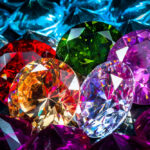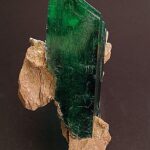Short answer: Precious gem stones
Precious gemstones are highly valued and sought after for their rarity, beauty, and durability. The four most recognized precious gemstones include diamonds, rubies, sapphires, and emeralds. These gemstones have a long history of being used in jewelry as well as for investment purposes. Their value is determined by factors such as color, clarity, cut, and carat weight.
How Precious Gem Stones are Formed and Mined
The world of precious gemstones is a captivating and dazzling realm that has captured the hearts and minds of people from all corners of the globe. From diamonds to rubies, sapphires to emeralds, these magnificent jewels are coveted for their intrinsic beauty and value. But have you ever wondered how these precious stones are formed and mined? Let’s take a journey deep into the earth’s crust to uncover the secrets behind these glittering gems.
The formation of precious gemstones begins millions of years ago when magma, trapped beneath the earth’s surface, begins to cool and solidify. As this process occurs, certain minerals and elements become trapped within the solidifying rock. It is these minerals and elements that give rise to some of the most beautiful gemstones in existence today.
One such mineral is carbon – this simple element is responsible for producing one of the most valued gems in the world: diamonds. Diamonds are formed under immense pressure and heat deep within the Earth’s mantle. Over time, volcanic eruptions bring diamond-rich rocks closer towards the surface where they can be found and mined.
But not all gemstones are formed through volcanic activity. Many other types of gemstone require specific geological conditions to form that are found in various locations across the world; topaz, aquamarine, tourmaline are just a few examples. The creation of each distinct category involves different combinations of temperatures , pressures , chemical reactions , and even oceanic movements .
Once a miner has identified an area with potential for gem-bearing deposits, they will begin excavating tunnels or open pits in search for veins or pockets where valuable minerals might be hiding.
Gemstone mining can range from small-scale operations using hand-held tools up to large-scale commercial mines employing heavy machinery such as bulldozers excavators . Regardless of scale there always have been significant risk involved because mining not only damages environment but also risks miners health unless performed reliably . Nonetheless traditional methods of artisanal mining use minimum equipment to preserve natural resources and to respond to the needs of a small-scale industry . Modern innovative techniques , for instance new filtering devices, can also allow companies to extract gemstones while minimizing environmental impact.
The excavation process is a delicate balance between removing enough material to uncover precious stones while not damaging these fragile gems. These coveted jewels are often found embedded within tough rocks that need precision drilling or careful handling with specialist gloves so as not to cause any damage.
Once extracted from the rock, gemstones still require further refinement before they’re ready for market. This refining process involves cutting and polishing each stone into its unique shape and size – often done by craftspeople who have spent years honing the trade.
In conclusion, the formation and mining of precious gemstones is a magnificent journey through time, science and art. It requires patience, skill, an appreciation for beauty in all its forms – yet the end result is nothing short of breathtakingly beautiful jewels that people cherish for generations. So whether you’re simply admiring their beauty or contemplating starting your very own gemstone collection – never forget the remarkable journey each stone has undergone before it falls into your hands!
Step-by-Step Guide to Identifying and Buying Precious Gem Stones
Precious gemstones have long been a fascination for humans due to their intrinsic beauty, rarity, and value. Buying such gems is a highly specialized niche that requires knowledge, skill, patience, and attention to detail. Without the necessary guidance or preparation, identifying and buying precious gemstones can be challenging.
In this step-by-step guide, we will walk you through the process of identifying and purchasing these valuable gems so you can make an informed decision that meets your needs.
Step 1: Know Your Precious Gemstones
Before you start shopping for precious gems, it is essential to understand exactly what they are. Precious gemstones are rare minerals that exhibit excellent durability alongside exceptional beauty. The most commonly known precious gems include diamonds, sapphires, emeralds and rubies.
Each of these stones has specific properties that distinguish them from other types of minerals. Diamonds are valued for their hardness and brilliance; sapphires for their vibrant blue color; rubies for their deep red hues; and emeralds for their vivid green shades.
Step 2: Identify the Quality Factors
When assessing the quality factors of a precious gemstone, there are several key elements you need to consider. These criteria determine the stone’s overall value:
Carat Weight: This refers to how much the stone weighs measured in carats (1 carat equals 200 milligrams).
Color: The color both determines the type of mineral/metal as well as its shade/intensity such as with diamonds that range from bluish-white to yellowish-brown colors while sapphires can vary from violet-blue shades to yellow or pink pastels.
Clarity: This is the absence of impurities in a gemstone visible under magnification.
Cut: The way in which a gemstone’s facets interact with light reflecting off them determines its cut grade .
By knowing how each value factor influences price point within different types of stones you can create a mental baseline for pricing out gems that meet your needs as well.
Step 3: Choose the right Jeweler
When a person buys a precious gemstone from an authorized dealer they receive significant benefits such as reputable certification, quality assurance and reliable customer service.
Therefore, before you buy any precious gemstone, ensure that you research thoroughly to find reputable sellers with long standing credibility in the market. Asking for references or feedback from previous customers is also advisable as part of your search for the ideal jeweler.
Step 4: Inspect Your Gemstones
When evaluating a gemstone after receiving it at home or in store all aspects of the stone must be examined. Ensure there isn’t any damage and check whether the size, cut and general appearance are consistent with what was suggested by the jeweler’s documentation. If there are markings on a diamond (or other stones) they must also have specific numbers that accompany them, known as certification details which verify its authenticity and quality grade.
Step 5: Make The Purchase With Confidence
Once you have inspected your precious gemstones and select the perfect one it is time to make your purchase. To complete this step with confidence ,make sure to ask any questions relevant throughout the process such as price points, warranty information or return policies so when it comes time to sign off on the deal ,you’re now reassured in making an informed decision.
In conclusion identifying and buying valuable gems can seem intimidating at times but once calculated steps have been taken towards education about various forms of minerals, research achieved concerning value factors alongside knowledgeable advice sourced from reputable dealerships; purchasing will become more of an enjoyable experience recognized for both its sentimentality & acquiring lasting heirlooms.
Precious Gem Stone FAQs: Answers to Common Questions
Precious gemstones have been coveted for centuries due to their breathtaking beauty, rarity, and powerful symbolism. These stones are not only stunning adornments but also carry spiritual and healing properties that make them even more valuable. However, with so much mystery surrounding these gems, there are several questions that potential buyers might want answers to before they invest in one. So we decided to come up with a list of FAQs that will help demystify the world of precious gemstones.
1. What makes a stone ‘precious‘?
Precious stones are scarce and are usually found in limited quantities in remote locations around the world. In addition, they have high durability and hardness compared to other minerals, making them ideal for use as jewelry or adornments.
2. What is the difference between precious and semi-precious gemstones?
The distinction between the two categories depends on their rarity and demands in the market. For instance, diamonds, emeralds, rubies, sapphires belong to the category of precious gemstones while gems like amethysts or garnets fall under semi-precious gemstones.
3. Why do some gems cost more than others?
Various factors contribute to why certain gems cost more than others; rarity is definitely higher up on the list because if a particular type of stone can’t be found easily anywhere else then it becomes very valuable based on its scarcity alone. Another determining factor could be related to how hard they are meaning if it’s harder to manipulate or work with the material then expect it being sold at a higher price point.
4. Can you differentiate original from fake gemstones?
Imitation or synthetic stones look similar but do not share any physical similarities with originalnatural ones when deeply observed under microscopic examination technology tools like spectrometers amongst others which automatically differentiates levels of atoms within minerals. Also worth noting is that genuine stones values easily deteriorate when exposed harshly whilst imitations like glass or plastic supplant preserve their facade thus genuine stones tend to be more delicate and expensive.
5. What are the popular precious gemstones people buy?
Emeralds, Rubies, Diamonds, and Sapphires are the most desired gemstones due to their vibrant color spectrums, exceptional hardness ratings,gemstone symbolism besides being a clear status symbol worldwide.
6. How should you take care of your precious gemstone or jewelry piece carrying it?
You must handle it with utmost care because these items can be very delicate which can cause damage if handled roughly.Gems in rings tend to rake up scratches over time when rubbed against other rough surfaces like walls or handbags so taking off accessories before doing manual house chores is advisable. Store them carefully in secure boxes as they’re prone to dust build-up too.
In conclusion, precious gems have always held a strong appeal owing to the enigma around them;they come loaded with history,charisma and boast captivating beauty that’s hard to miss. They convey deep rooted cultural meanings while also offering subtle therapeutic benefits. Whether set in exquisite jewelry pieces or standing alone as polished curiosities- these minerals will undoubtedly always carry intrinsic value for those that appreciate such treasures.
Top 5 Surprising Facts about Precious Gem Stones
Gemstones have been treasured throughout history for their beauty, rareness and value. They are believed to have powerful healing properties and mystical qualities that enhance our lives. For centuries, people have collected gemstones as a symbol of wealth, status, and love. However, there are some surprising facts about these precious gemstones that may not be well known.
1. Diamonds are not the rarest gemstone
Although diamonds have been traditionally considered the most valuable gemstone due to their rarity, it is actually an erroneously held belief. According to gemmological records, alexandrite is rarer than diamond as only a few deposits have been discovered in Russia, Brazil and Tanzania.
2. Sapphires come in many colors
Sapphires are usually associated with deep blue color but they do appear in other shades such as green, pink, purple and golden yellow hence making them among the versatile gems worldwide. One of the world’s largest sapphire deposits was recently discovered in Madagascar.
3. Emeralds contain flaws
The deep green emerald stands out among all other green stones however; it’s worth noting that natural emeralds often contain flaws which can be seen under magnification hence lowering its value compared to flawless diamonds or sapphires.
4. Rubies might not really be Ruby
Did you know that most rubies sold today could actually be corundum? In order for red corundum stone to qualify as ruby hereto must demonstrate quality plus hue determined per geographical location eg pigeon blood red ruby from Burma while a reddish/pink Corundum be classified as Sapphire.
5. Topaz has pleochroism!
While frequently found in clear blue hues like the sky on a bright day or light brown color ranging into intensively orange turns out this beautiful stone has another more unique characteristic called pleochroism which means different colors of topaz emerge when viewed at different angles.
To sum up…
Despite their beauty and value, gemstones are surrounded by many myths and misconceptions. Knowing the surprising facts about these precious stones will give a new appreciation to these masterpieces of nature. Whether you’re an admirer or collector, you can now spread the word about the fascinating world of gemstones!
The Healing Properties of Precious Gem Stones: A Complete Guide
The world of precious gemstones has always been shrouded in mystery and wonder. From ancient times, we have revered these natural wonders for their beauty, rarity, and symbolism. But did you know that many precious gemstones are also believed to possess healing properties? That’s right – beyond their aesthetic appeal, certain gemstones are said to have powerful therapeutic effects on the mind and body.
So if you’re looking for a holistic approach to wellness or simply want to add some sparkle to your life, read on for a complete guide to the healing properties of precious gemstones.
Amethyst: Calming and Soothing
First up is amethyst – a stunning purple stone that’s often associated with spirituality and meditation. Amethyst is believed to have calming and soothing qualities that can ease anxiety and stress. It’s thought to promote better sleep as well, making it an ideal gemstone for those who struggle with insomnia or restless nights.
Citrine: Energizing and Motivating
If you need a boost of energy or motivation, citrine might be just the thing. This yellow-orange gemstone is thought to help awaken creativity, stimulate mental clarity, and increase self-confidence. It’s also considered a powerful manifestation stone – meaning that it can help you bring your dreams into reality.
Rose Quartz: Love and Compassion
Known as the “stone of love,” rose quartz is associated with matters of the heart. This gentle pink stone is said to promote compassion, kindness, empathy, and forgiveness – all important traits when it comes to cultivating healthy relationships (with others as well as yourself). Rose quartz can also assist in healing emotional wounds from past traumas.
Turquoise: Protection and Healing
For centuries, turquoise has been considered a sacred stone by Indigenous cultures across the world. This beautiful blue-green gemstone symbolizes protection against negative energy, physical harm or illness; emotional balance& stability; intellectual ambition & insight among other properties. It is believed to have powerful healing properties, particularly when it comes to aiding in the recovery from physical injury.
Garnet: Grounding and Fortifying
If you’re feeling scattered or unfocused, garnet may be able to help. This dark red stone can help ground you, bringing about feelings of stability, security and increased focus. Garnet has also been said to sharpen your intuition.
Sapphire: Wisdom and Insight
Sapphires aren’t just jewels for royalty – they also hold deeper meaning in terms of spiritual growth and insight. This blue gemstone is believed to promote wisdom, knowledge and critical thinking skills; enhance personal expression & communication abilities; stimulate psychic awareness among others.
In summary, precious gemstones are much more than just beautiful adornments- they hold a wealth of therapeutic benefits that can help heal us both physically and emotionally. From calming amethysts to energizing citrines, each gemstone has its own unique properties that can assist us in achieving balance and harmony within ourselves.
It’s important to note that while these gemstones are believed to have healing qualities, they should never be used as a substitute for professional medical treatment. As with any wellness practice, it’s always best practice engage a certified practitioner or therapist who understands the energy dynamics involved as well as could recommend an appropriate course of action depending on the condition being treated.
So whether you’re looking for some inner peace or simply want to add some sparkle and positivity into your life – now’s the time to start exploring the magical healing powers of precious gemstones!
Famous and Iconic Pieces Featuring Precious Gem Stones
Gemstones have been popular for centuries, serving as a symbol of wealth, status, and beauty. Throughout history, many famous and iconic pieces have featured precious gemstones that capture the imagination and inspire awe.
One of the most well-known examples is the Hope Diamond. This rare blue diamond was originally mined in India and now sits in the Smithsonian Museum in Washington D.C. The stone is said to be cursed due to its tumultuous history which includes multiple owners who experienced misfortune or tragedy after possessing it. Despite this, it remains one of the most famous diamonds in the world with its vibrant blue color attracting visitors from all over.
Another iconic piece featuring precious gemstones is Queen Elizabeth II’s Imperial State Crown. This stunning piece is adorned with over 3,000 diamonds including large white diamonds like the Cullinan II which weighs nearly 317 carats alongside smaller rubies, sapphires and emeralds used for accents throughout the piece. It has become an iconic symbol of British royalty.
The Star of India is another legendary gemstone with a rich history dating back to ancient times. A massive 563-carat sapphire that glows with a striking blue hue that changes at every angle showcasing its countless facets etched into its surface giving a star-like appearance upon light reflecting against it. Discovered hundreds of years ago near Sri Lanka’s coastlines shrouded in mystery and surrounded by legends of Indian maharajahs, pirates hunting treasured gems or stolen by exotic thieves, The Star of India now resides at New York’s Museum of Natural History as part of their collection.
The Taj Mahal Diamond on Shah Jahan’s Peacock Throne signifies true love since The Taj Mahal was built by Shah Jahan in memory and devotion towards his wife Mumtaz Mahal; whom he had promised to give her nothing but the world hence commissioned to create perhaps one sought after throne in history – The Peacock Throne. A shining gold divan decorated with exquisite gemstones such as emeralds, sapphires and rubies. At the center of the peacock throne is where the Taj Mahal Diamond rests glowing at every angle via a yellow diamond nearly 106 carats.
Everywhere in antiquity royalty expressed their grandeur and power found in precious gems harnessed in a variety of ways. It just takes appreciating these extraordinary pieces to uncover how intricate design work and skilled craftsmanship have brought them to life- never ceasing to leave admirers dazzled.
Table with useful data:
| Gemstone Name | Color | Hardness on Mohs Scale | Location |
|---|---|---|---|
| Diamond | Colorless or fancy colors | 10 | South Africa, Russia, Canada, Australia |
| Emerald | Green | 7.5-8 | Colombia, Brazil, Zambia |
| Ruby | Red | 9 | Myanmar, Thailand |
| Sapphire | Blue (also comes in other colors) | 9 | Sri Lanka, Madagascar, Australia |
Information from an expert
As a gemstone expert, I know that they have been treasured for centuries for their stunning beauty and rarity. Gemstones come in a variety of colors and are often used in jewelry as well as decorative objects. Some of the most precious gemstones include diamonds, rubies, sapphires, emeralds, and pearls. These stones can be valuable not only because of their aesthetic appeal but also because of their rarity. Each gemstone has unique properties and characteristics that make it special. As an expert, I am passionate about educating others on the value and importance of these magnificent stones.
Historical fact:
The ancient Greeks believed that diamonds were fragments of stars that had fallen to earth, making them highly prized as objects of power and romance.
![Uncovering the mysteries of precious gem stones: a fascinating story, practical tips, and eye-opening stats [ultimate guide for gemstone enthusiasts] - gulfgemology](https://gulfgemology.com/wp-content/uploads/2023/04/tamlier_unsplash_Uncovering-the-Mysteries-of-Precious-Gem-Stones-3A-A-Fascinating-Story-2C-Practical-Tips-2C-and-Eye-Opening-Stats--5BUltimate-Guide-for-Gemstone-Enthusiasts-5D_1681334995.webp)
![Uncovering other gems: a story of discovery and practical tips [with statistics and solutions] - gulfgemology](https://gulfgemology.com/wp-content/uploads/2023/04/tamlier_unsplash_Uncovering-Other-Gems-3A-A-Story-of-Discovery-and-Practical-Tips--5BWith-Statistics-and-Solutions-5D_1681334996-150x150.webp)
![Uncovering the power of righteous gem stones: a personal story and practical guide [with stats and tips] - gulfgemology](https://gulfgemology.com/wp-content/uploads/2023/04/tamlier_unsplash_Uncovering-the-Power-of-Righteous-Gem-Stones-3A-A-Personal-Story-and-Practical-Guide--5Bwith-Stats-and-Tips-5D_1681334994-150x150.webp)




